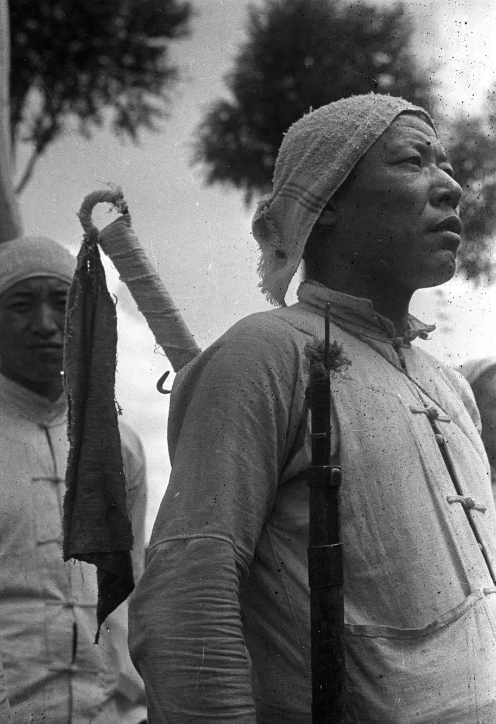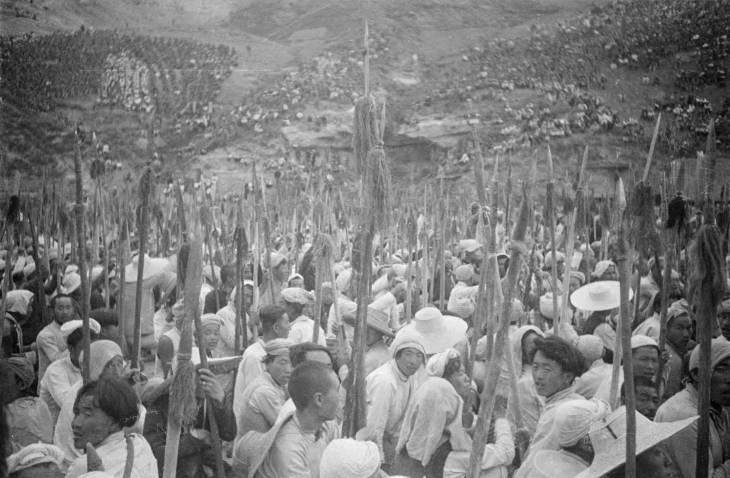
I find I’m getting increasingly fascinated by the concept of ritual, magic, and how it relates to Chinese martial arts. I think I’ve just never been satisfied with the explanation that forms in Chinese martial arts are there for cataloguing techniques. There are many martial arts in the world that do not require forms to catalogue either their techniques or body methods (Shen fa). When something like that so obviously doesn’t add up, I think there has to be something else going on. But what?
It’s been a long time since I’ve linked to Ben Judkins excellent website Kung Fu Tea, but I’m going to recommend that you give this article a read. It’s about the biggest group of 20th century Chinese ‘martial artists’ that you’ve probably never heard of. They were called The Red Spears. And despite having a membership in the millions (millions!) they tend to get wiped from modern historical accounts of Chinese martial arts. Made up of poor, usually illiterate members, they existed away from the cities and the urban areas, where all the well known marital arts groups like the Jingwu Association and the Koushu Association existed. Urban association tended to write books and leave more newspaper articles as evidence for historians. The Red Spears had the numbers, but they were out in the sticks, and out there, less ‘scientific’, ‘outsider’ and ‘western’ ideas pervaded. There we find war magic, rituals and mystical arts.

The Red Spears, as effective grassroots organisers in local areas seemed to perform something of the same function as elements of the historical Yakuza in Japan, stepping in when local authorities overstep their mark and being effective at “getting things done”.
And despite the name Red Spears, let’s not forget that these militia groups, like all militia groups, carried rifles. Performing magic rituals and being in a secret society did not mean they rejected all modern technology.
The article contains a report called “Background and Doings of China’s Red Spears By Norman D. Hanwell (Asia Magazine), The China Weekly Review, August 19, 1939. Page 381” which talks about practices that don’t seem a million miles away from what we would call chi kung these days, if you made it more secular and removed the practices we would call superstitious.
“Through the customs of the Red School probably differ from locality to locality and naturally the secret part of their program is difficult to confirm, since no outsider is permitted to attend, there are descriptions by Chinese in print. In some sectors members of the Red School “got to school” in a temple each evening. Arriving with their red-tasseled spears. Reaching the School Hall they come before the incense altar common to all Chinese Temples, bare their backs and kneel to listen to one their leaders lecture. Following this, each one breaths deeply and beats his breast, ending with the shouting of the slogan “Chi Kung lai yeh!”—a phrase difficult to translate. Perhaps it might be compared to “The gods be with us!” a short incantation from which strength may be obtained. Out of this process some of the Red Spears are convinced of their invincibility in battle and immunity to death therein.
The Type of Training
Certain persons profess to find in this type of training some scientific basis. For example, the regular evening attendance, the listening to lectures and the sitting in meditation are good training, they claim, for the development of the quality of serenity or tranquility. The practice of holding the breath and beating the breast is excellent for developing the lungs. The crying out of the slogans is declared to be good training for breath control. Whether we accept any of these “scientific” values or not, we must admit that there are psychological advantages to be obtained from these practices. The peasant convinces himself of his own ability to undertake certain tasks, and his conviction inevitably increases his effectiveness.
A recently made investigation of the White Spear Society of Anhwei Province, an area now under Japanese occupation, reports that the superstitious “Chu kung lai yeh!” has been replaced by slogans more appropriate to present activities. Among these are “Kill the Eastern Sea Devils”—that is, the Japanese—and “Kill the Traitors”—that is, those Chinese cooperating with the Japanese.”
As you can see, the report talks about breath control, tranquility training, hitting the body to strengthen it and gain invincibility (The shouting of the slogan “Chi Kung Lai yeh!” may have some relevance, but who knows…? That may simply have been the historical equivalent of “Let’s do this!”)
I’m increasingly wondering how much of modern Chinese martial arts is built on all this long forgotten training from a different time and setting. It’s interesting to ponder.
I wrote about cults in marital arts yesterday. I think its pretty clear that The Red Spears would fit the definition of a cult, but by modern standards they are way more extreme than anything the Tai Chi world can conjure up today. Forget expensive training camps. They actually led their members into armed conflicts, battles and more! That’s also an interesting topic to consider.







